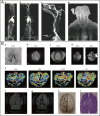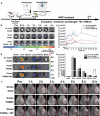Advancing neuroimaging: novel manganese- and iron-based MRI contrast agents for cerebral ischemic diseases
- PMID: 40824432
- PMCID: PMC12361001
- DOI: 10.1186/s11671-025-04325-4
Advancing neuroimaging: novel manganese- and iron-based MRI contrast agents for cerebral ischemic diseases
Abstract
Cerebral ischemic diseases remain a significant clinical challenge, necessitating advancements in imaging technologies to improve diagnosis and therapeutic monitoring. This review highlights the limitations of gadolinium-based contrast agents (GBCAs), particularly their nephrotoxicity and limited specificity, and explores the emerging role of manganese- and iron-based MRI contrast agents as promising alternatives. Manganese-based agents demonstrate exceptional sensitivity to neuronal activity and metabolic changes, making them highly effective for assessing functional and cellular dynamics. Meanwhile, iron-based agents leverage their superparamagnetic properties to enhance ischemic lesion detection, particularly in T2-weighted imaging. However, the clinical translation of these novel agents faces significant challenges, including biosafety concerns, suboptimal targeting efficiency, and the need for multimodal integration to improve diagnostic precision. Future research should focus on the development of low-toxicity, biodegradable contrast agents with enhanced targeting capabilities, the application of artificial intelligence for probe optimization, and the creation of theranostic nanoprobes that combine imaging with targeted therapy. Additionally, rigorous clinical validation and the establishment of standardized protocols will be critical for integrating these agents into routine practice. These advancements hold the potential to revolutionize ischemic stroke diagnosis and enable precision neuroimaging, driving the broader adoption of novel MRI contrast agents in clinical workflows.
Keywords: Cerebral ischemic; Iron-based MRI contrast agents; Magnetic resonance imaging; Manganese-based MRI contrast agents; Theranostic.
© 2025. The Author(s).
Conflict of interest statement
Declarations. Ethics approval and consent to participate: not applicable. Clinical trial number: not applicable. Competing interests: The authors declare no competing interests.
Figures





Similar articles
-
MarkVCID cerebral small vessel consortium: II. Neuroimaging protocols.Alzheimers Dement. 2021 Apr;17(4):716-725. doi: 10.1002/alz.12216. Epub 2021 Jan 21. Alzheimers Dement. 2021. PMID: 33480157 Free PMC article.
-
Prescription of Controlled Substances: Benefits and Risks.2025 Jul 6. In: StatPearls [Internet]. Treasure Island (FL): StatPearls Publishing; 2025 Jan–. 2025 Jul 6. In: StatPearls [Internet]. Treasure Island (FL): StatPearls Publishing; 2025 Jan–. PMID: 30726003 Free Books & Documents.
-
Oral Manganese Chloride Tetrahydrate: A Novel Magnetic Resonance Liver Imaging Agent for Patients With Renal Impairment: Efficacy, Safety, and Clinical Implication.Invest Radiol. 2024 Feb 1;59(2):197-205. doi: 10.1097/RLI.0000000000001042. Epub 2023 Nov 7. Invest Radiol. 2024. PMID: 37934630 Free PMC article. Review.
-
Multimodal imaging in cancer detection: the role of SPIONs and USPIONs as contrast agents for MRI, SPECT, and PET.Future Oncol. 2025 Aug;21(18):2367-2383. doi: 10.1080/14796694.2025.2520161. Epub 2025 Jun 18. Future Oncol. 2025. PMID: 40531182 Review.
-
MarkVCID cerebral small vessel consortium: I. Enrollment, clinical, fluid protocols.Alzheimers Dement. 2021 Apr;17(4):704-715. doi: 10.1002/alz.12215. Epub 2021 Jan 21. Alzheimers Dement. 2021. PMID: 33480172 Free PMC article.
References
-
- Zhou M, Wang H, Zhu J, Chen W, Wang L, Liu S, et al. Cause-specific mortality for 240 causes in China during 1990–2013: a systematic subnational analysis for the global burden of disease study 2013. Lancet. 2016;387(10015):251–72. - PubMed
-
- Wang W, Jiang B, Sun H, Ru X, Sun D, Wang L, et al. Prevalence, incidence, and mortality of stroke in china: results from a nationwide Population-Based survey of 480 687 adults. Circulation. 2017;135(8):759–71. - PubMed
Publication types
Grants and funding
- SLCZDZK202202/Chongqing Key Clinical Specialty Construction Project
- SLCZDZK202202/Chongqing Key Clinical Specialty Construction Project
- SLCZDZK202202/Chongqing Key Clinical Specialty Construction Project
- CSTB2022NSCQ-MSX0113/Chongqing Municipal Natural Science Foundation
- CSTB2022NSCQ-MSX0113/Chongqing Municipal Natural Science Foundation
- CSTB2022NSCQ-MSX0113/Chongqing Municipal Natural Science Foundation
- CSTB2022NSCQ-MSX0113/Chongqing Municipal Natural Science Foundation
- cstc2021jcyj-msxmX0117/National Natural Science Foundation of Chongqing
- cstc2021jcyj-msxmX0117/National Natural Science Foundation of Chongqing
- cstc2021jcyj-msxmX0117/National Natural Science Foundation of Chongqing
LinkOut - more resources
Full Text Sources
